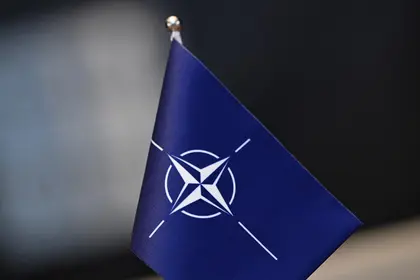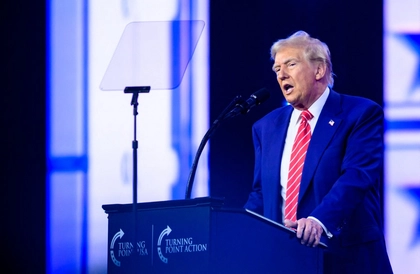Twenty-four months ago, the United States and their NATO partners valiantly rose to the occasion to support Ukraine in the defense of their country from Russian President Vladimir Putin’s “special military operation.”
Yet the White House failed to offensively transition with Ukraine as Kyiv began recapturing occupied territory; rather, the Biden Administration remains stuck in the defend and ‘weaken Russia’ mode. There still is no plan to defeat Russia or a clearly articulated end state by the Biden Administration.
JOIN US ON TELEGRAM
Follow our coverage of the war on the @Kyivpost_official.
On Tuesday Deputy Pentagon Press Secretary Sabrina Singh reiterated that position when she told reporters, "we are going to continue to urge Congress to pass this urgent supplemental request so that we can deliver Ukraine the air defenses, artillery, and ammunition they need to defend themselves."
Ukraine has returned to survival mode and defensive weapons are a necessity, but this will not end until someone wins. Sixty billion in US assistance will not accomplish that – but it would buy time for Ukraine to reset. Ukrainian President Volodymyr Zelensky and his generals need offensive weapons to win. There is tough sledding ahead – are the US, NATO and the European Union prepared to stay the course?
Right now, a weakened Ukraine is playing to the strength of Russia – allowing them to mass artillery against their static defenses and then assault them in mass with troop formations utilizing frontal assaults reminiscent of the first World War. Kremlin logic being Ukraine will run out of ammunition before Russia runs out of soldiers. They were right in Avdiivka, but Moscow lost upwards of 120,000 soldiers proving that theory from Oct. 9 to Feb. 20.

‘I Was Saved by God to Make America Great Again’ – Trump Launches Retaliation Tour and Far-Right Agenda at Inauguration
Is Putin prepared to do the same in Krynky, Verbove, Robotyne, Synkivka and Ivanivka?
It is highly likely.
Ukraine has lost the initiative, and now their valiant soldiers await the next Russian assault on their defensive positions and hope they do not run out of ammunition as Washington falters. But as the late US Army General Gordon R. Sullivan once penned: Hope is not a method. Hope is trending south in Ukraine – they need a shot of adrenaline; Washington needs a shot of calcium to regain its backbone.
Confidence is waning in the absence of American leadership and resolve – and domestic disputes about the US southern border. Alarmingly, according to a recent European Union poll, only “one in ten Europeans believe that Ukraine can defeat Russia.” That perception is only compounded by articles proclaiming Ukraine can no longer win.
Absent now are the tanks and infantry fighting vehicles – and the ability to maneuver on the battlefield – that were once the strength of the Ukrainian military and a weakness the Russian defense had no answer for. But the time afforded to Russia last winter gave them the opportunity to dig in, seed minefields, and fortify their defensive positions in depth. Putin and his generals clearly were able to hit the reset button.
Ukraine’s static defense is a losing proposition – as we have seen in Avdiivka. Sooner or later, it will come down to ‘fix bayonets’ or withdraw to fight another day. Make no mistake about it, Putin’s military did not win the battle for Avdiivka, they simply occupied the town when the Ukrainians left.
Nearly 12 months earlier in Bakhmut, Ukraine had the ammunition and repelled the relentless assaults for Yevgeny Prigozhin’s Wagner Group mercenaries – a much better trained and equipped force – for months with a regional defense force while the Ukrainian Army prepared for their spring counteroffensive.
The US has become a liability to Ukraine and its NATO allies – allegiance to political party has taken precedence over national and global security and promises made to “stand by Ukraine for as long as it takes.” Ukraine is running on empty – and allies are losing faith.
In the absence of American leadership, individual European countries – the United Kingdom, Germany, France and now Denmark – are establishing unilateral security guarantees while others are working to provide Ukraine funding and military assistance directly.
Unlike the US, Russia has a plan and an end state, and they are slowly making progress towards obtaining it. It is a threefold assault – targeting the Ukrainian military, the Ukrainian civilian population, and their hope.
Despite their losses, according to Ukraine's Military Intelligence Agency (HUR), Russia has over 450,000 soldiers deployed in Ukraine. The pick-up game of whoever the Kremlin can muster, put into uniform, and get to the front lines is accompanied by an assortment of Korean War vintage weapons. One word best describes the effort – mass. The intent – wear down the Ukrainian defenders, exhaust their ammunition supplies, remove hope, and keep moving forward whatever the cost. Russian barrier troops will ensure that happens.
And while they wear down the defenders on the front lines, Russia purchased 400 Iranian missiles “from the Fateh-110 family of short-range ballistic weapons … with ranges between 186 and 435 miles,” sending a clear message that they intend to continue striking civilian targets.
The cost of interdicting Putin’s newly acquired missiles with the Patriot Missile system would be about $1.6 billion – or $4 million per missile. And that does not include the cost of defending against ballistic missiles Russia has purchased from their other ‘arsenal of evil’ partner – North Korea – specifically the Hwasong-11A (KN-23) and Hwasong-11B (KN-24) short-range ballistic missiles.
On Jan. 4, National Security Council Coordinator John Kirby confirmed the purchase, telling reporters: “Our information indicates that the Democratic People’s Republic of Korea recently provided Russia with ballistic missile launchers and several [dozen] ballistic missiles.” On Feb. 22, the Security Service of Ukraine (SBU) reported that Russian troops had “launched over 20 North Korea-made missiles to attack Ukraine, killing at least 24 civilians and injuring over 100.”
Make no mistake about it, Putin intends on firing every one of those missiles – and buying more when they are exhausted.
Interdicting individual missiles in flight does not remove the threat though. Enabling Ukraine to strike the missile launchers, their crews, and the facilities where the missiles are stored would be a better course of action. Kyiv urgently needs precision deep strike capability to remove the threat – ATACMS, Taurus, jet fighters, etc., then the greenlight from the US and NATO to take them out in Russia.
As Peter Dickinson states in the Atlantic Council: “As long as Western leaders insist on restricting Ukraine’s ability to strike back at Russia, Ukrainian commanders will be forced to continue fighting with a shield but no sword.”
On Thursday, NATO Secretary General Jens Stoltenberg made a positive step in that direction, stating “Ukraine has a right to use its Western-supplied weapons to defend itself against Russia, even if that includes striking targets within Russia's borders.” He went on to say, "According to international law, Ukraine has the right to self-defense. And it also includes strikes against legitimate military targets, Russian military targets outside of Ukraine…Ukraine has the right to do that to defend itself."
But will the US and Germany adopt that methodology? As long as Putin retains a nuclear capability, probably not. The White House remains unduly paralyzed by escalation fears. Knowing this, Putin is not shy in reminding the West of this capability either. On Thursday he took a short flight on a Tu-160M nuclear-capable strategic bomber to reinforce that message.
As the saying goes, “there is no I in team,” but Washington has managed to remove the M and E – making it about me, the political party. Carl von Clausewitz once stated, “war is not merely a political act but a real political instrument, a continuation of political intercourse, a carrying out of the same by other means.” Right now, in Washington – there is no act, nor instrument, and the repercussions are being felt in Ukraine.
Putin relishes in the opportunities afforded to him. Washington is playing into his plan.
Regardless of calls for peace talks, Putin will not stop in Ukraine. He may pause but he will not stop. Notably, the Institute for the Study of War published on Feb. 22 that “Transnistria may organize a Referendum on Annexation to Russia to support Russian hybrid operations against Moldova.”
As the fictional character Andy Dufresne intoned to Red in the Shawshank Redemption, “Get busy living or get busy dying.” It is time for Washington to get into the business of living and right the course – to rebuild hope and confidence. Winning changes everything – yet Ukraine cannot win from a defensive position, only absorb the blows. Defend or win – that is the question.
Truth be told, the security of the U.S. southern border will not matter if Ukraine falls. America will be far less secure and Putin’s war against the West ever closer to London and their NATO allies.
Washington must get its priorities in order. The future of Europe and the free world is at stake in Ukraine.
You can also highlight the text and press Ctrl + Enter










